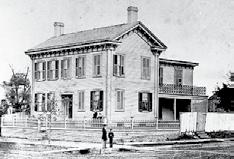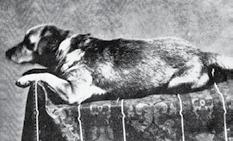
14 minute read
Abraham Lincoln’s Dog, Fido Kate Kelly
Abraham Lincoln’s Dog, Fido
Kate Kelly
Advertisement
In the 1850s, the Lincoln family acquired a yellow mixed-breed dog they named Fido. Fido often accompanied Lincoln to his Springfield law office or around town on errands. Fido also loved being with the Lincoln boys, Willy and Tad, and he was known to most people in Springfield.
Fido’s Story
In the mid-19th century, few families could afford pets, but dogs were plentiful in most communities. The strays scavenged for food around local eateries and found barns where they could sleep. These dogs were generally called “tramps.” (This may explain the Disney title, “Lady and the Tramp.”) Only a lucky few of the dogs found themselves with a home to live in and a family to love. Fido was one of them.
Lincoln had not had an easy childhood, and his hardscrabble background gave him a soft spot for children and for animals. He rarely disciplined his sons, and of course, if a cat or a dog found their way to the Lincoln household, they were not turned away. (His wife Mary did not feel the same way. Springfield streets could be very muddy, and Mary did not like all the dirt tracked in by the children, and later, the dog.)
Robert Lincoln was away during much of this time. He was older than his brothers (born in 1843). In 1859, he was sent to boarding school, Phillips Exeter Academy.
The Lincolns Adopt Fido
Rough-coated yellow dogs like Fido were common at that time. (Lincoln had owned another “yaller dog” named Honey when younger.)
Fido must have arrived in the household by 1855 as historians can produce an invoice for vermifuge, a “de-wormer,” from the Springfield drugstore. Whether the family found him, or whether he chose them, is a story we do not know but certainly by the mid-1850s, the Lincolns had Fido living with them.
While today the name “Fido” is so common that it’s used generically to refer to canine “pets.” Fido is from the Latin “fedelitas” for faithful, so naming the dog Fido was likely very high praise for the dog.
At the time, the most popular name for dogs was Carlo, according to Matthew Algeo, author of the book, Abe & Fido. The name “Carlo” was popular among the well-read, as it was the name of the faithful pointer in Jane Eyre.
Family Dog
Fido was very much a “house dog.” The streets of Springfield were often muddy, so between Willy and Tad and Fido, the house must have been difficult to keep clean. Over Mary’s protests, Fido sometimes climbed into bed with one of the boys. He amused the family by chasing his tail in the drawing room. At dinner, Abe and the boys were happy to pass him scraps from the table.
Before Lincoln became president, Fido’s days were generally spent out with one family member or another. If Lincoln was doing errands, Fido went along with him and was sometimes given the responsibility of carrying Lincoln’s purchase. Fido was also well known at the barbershop. Billy the Barber was an institution in Springfield, and since Abe went in regularly for shaves (he was clean-shaven until late 1860), Fido often went, too.
When Lincoln went to his law office, Fido could have accompanied him, but chances were good that he went to find Willy and Tad instead. He could wait for them at school, or Willy and Tad were often out and about with friend. Fido liked joining them.
Like other dogs of the same time period, there was no particular effort at training Fido. He came and went as he pleased, and because Lincoln tended to indulge both his children and their pets, no one ever broke Fido of his habit of jumping up on people to cheerfully lick hello. With the muddy streets of Springfield, Fido did sometimes annoy.
Presidential Campaign
During the mid-19th century, it was considered unseemly for presidential candidates to campaign. Instead, party representatives traveled on a candidate’s behalf, and as many people as possible were asked to write letters in support Winter 2021



of one candidate or another.
In 1860, Lincoln faced a four-way election: Stephen Douglas represented the Northern Democrats, John C. Breckinridge ran on the Southern Democratic ticket, and John Bell represented the Constitutional Unionists.
The election was unlike any other. Lincoln knew that the country was at stake. Lots of planning was taking place with advisors and campaign managers traveling to Springfield to meet with Abraham Lincoln. Most meetings were at Lincoln’s law offices, but Lincoln sometimes brought men home to continue their talks.
Fido was restless and anxious from all the activity around his master, but there wasn’t much Lincoln could do about it.
When the election results were announced in November (still months from when the family would depart for D.C. in March), Springfield erupted in excitement. Cannons were fired, fireworks set off, and bands played. The town was filled with a cacophony of sounds, all of which sent Fido to hide behind the drawing room couch or upstairs under the boys’ bed.
What To Do With Fido
In observing how upsetting all the noises were for Fido, the future president had to consider what the family faced in Washington. He knew the capital was louder than Springfield, and he couldn’t imagine Fido feeling comfortable traveling by train with the family.
With difficulty, he discussed with Willy and Tad that there was just no way for Fido to come along. With protests from the kids and tears from them all, Lincoln got the boys to focus on where Fido could stay until the Lincolns returned to Springfield.
After considering various possibilities, the Lincolns all felt that The Roll family would be the right place for Fido.
John Roll was one of Lincoln’s oldest friends. Roll was just 16 when Lincoln, age 20, hired him to help build a flatboat that Lincoln planned to use to haul goods down the Mississippi. Since that time, John Roll became a contractor in town, and he and his wife had boys about the same age as Willy and Tad. The Rolls family also lived near the Lincoln home on 8th Street, so the boys all played together. Fido was often with them and always greeted the Rolls boys with big licks on face and hands.
Roll Family Agrees
When Abe pitched the idea to John Roll, he had several requests concerning Fido: -They were never to tie him up in the backyard by himself.
He was a house dog, so he should be allowed inside when he scratched at the door. -He was not to be scolded for having muddy paws. -He should be permitted to join the Roll family at dinner. Fido was accustomed to



Continued Next Page


being fed by everyone at the table.
Lincoln also had one other thought. Would the family like their couch that was specially made for Abe? It was green horsehair—7 feet long to accommodate the president’s height. Fido loved being on or near the couch, too.
John Roll and his family were honored to help, and they agreed to all the points that were specified by the Lincoln family. Also included in the plans were the fact that when the Lincolns returned to Springfield, Fido would come back to live with them.
The Family in Washington
In March of 1861, the Lincoln family made the move to Washington, D.C. to live in the executive mansion. Despite the war, Willy’s and Tad’s lives proceeded the way the lives of most young boys do with school and playtime.
Pets continued to be welcomed by Abe Lincoln and his sons. The boys had ponies, white rabbits, and two goats that kept them endlessly amused. Willy and Tad liked hitching Nanny and Nanko to a cart—or even a kitchen chair—to be pulled around.
The goats, however, were not always popular with the White House staff as they tended to chew up things they weren’t supposed to.
Tad became very attached to a turkey that was being raised for Christmas dinner. At Tad’s behest, Lincoln had little choice but to spare the turkey. The turkey lived on with the Lincolns as a pet, and Tad gave him full run of the mansion. (Lincoln’s own childhood was filled with fear and disappointment, so he chose to raise his boys with much more leniency.)
There is also mention of a dog at the Executive Mansion. A visitor recalls a “very beautiful little dog” who could stand up on his back feet quite comfortably. The person referred to the dog as “Jip” or “Gyp.”
Lincoln Loved Cats
Another visitor talked of a chair pulled up to the dining table by the president. A cat sat by the president enjoying a meal with the family. Perhaps Mary Lincoln was away at that time?
Lincoln himself was particularly fond of cats. According to the staff at Abraham Lincoln’s birthplace, if Mary Lincoln was asked about whether her husband had a hobby, she was very likely to answer “cats.”
In March of 1865 as the Civil War was coming to a close. All the requirements of rebuilding the country were being presented to the president. He frequently sat at the telegraph office in Washington so he could send and receive messages easily.
While there one day, Lincoln became distracted by three stray kittens. When he was informed that the kittens’ mother had died, he sat with them on his lap for a few minutes and then before he left, he made certain someone there committed to taking care of them.
News from Springfield
The Lincoln family did not have opportunities to return to Springfield. Travel at that time was arduous, and with the ongoing war, President Lincoln remained in Washington except when the war called him elsewhere. However, the family received reports from townspeople.
One of the best correspondents reporting to the Lincoln was Billy the barber. Billy, of course, knew all about what was going on in town, and he often reported a bit about Fido. At the end of a newsy report about the town, Billy added: “Tell Taddy that his (and Willy’s) Dog is alive and Kicking, doing well, he stays mostly at John E. Roll’s with his Boys who are about the size now that Tad and Willy were when they left for Washington.”
Lincoln’s Funeral
Fido was still living with the Rolls family when Lincoln was assassinated. When the funeral was held, mourners stopped in at the Lincoln family home in Springfield to



pay their respects. The Roll family brought Fido to say good-bye to his master, too.
In 1853, Abe Lincoln bought a horse that he called Old Bob. When the family departed for Washington, Lincoln sold Bob to an Irish drayman. Old Bob pulled one of the fellow’s delivery wagons.
When the body of the president arrived in Springfield to be buried, the deliveryman provided Old Bob for the funeral procession, Old Bob wore a mourning blanket with silver fringe, and he walked immediately after the hearse carrying the President’s body.
Fido Meets His End
During the year following Lincoln’s death, Fido continued to live with the Roll family. One day he didn’t come home. The family looked for him for several days before one of the boys heard that he might be over in the community churchyard. When they arrived there, they found Fido curled up and motionless. He had a knife wound. He must have crawled to a spot where he could find shelter to die.
Later the story was pieced together by community members. Like other towns, Springfield had its share of drunks. One of them was sitting on a curb downtown when Fido must have greeted him, perhaps with the muddy paws that he was well-known for. The fellow pulled a knife and stabbed him. Because Fido got away, no one realized a serious wound had been inflicted until the family reported that Fido hadn’t come home.
It was too late to save Fido but the Rolls family saw that he had a loving farewell.
First Photo of a Presidential Pet
Today we have two similar images that show us what Fido looked like. (See below to read how these were found.)
Up until recently, most historians felt that the photograph was likely taken before the Lincolns left Springfield.
More recently, however, it has been speculated that it is more likely that Fido’s photo was taken after the assassination. (The clue to that has to do with the photographer, “Ingmire” who is identified as having taken the photograph. When more town history was researched, it seems that Ingmire did not have a photo studio in 1860.)
For the funeral, the town was overrun by people. Visitors wanted to buy items related to Lincoln. A townsperson may have decided that that a photo of Fido would sell well.
At the time, photographs were sometimes copied and made into carte-de-visite (calling cards of a sort which were very popular during the Civil War when family members wanted to be remembered). Shortly after Lincoln’s death, the photo of Fido was reproduced as a carte-de-visite and sold to souvenir collectors.
Either explanation leaves us with the undeniable fact that we have the first photo ever taken of a Presidential dog. Winter 2021
How the Photo of Fido Was Found
Until about the 1940s, no one knew the story of the Lincoln family and Fido. However, thanks to an avid photo collector and his daughter, the two images of Fido led to details of the story.
Frederick Hill Meserve (1865-1962), a well-to-do executive in the textile industry, had a hobby that became all-consuming. His father fought in the Civil War and left behind a diary. Meserve wanted photographs to further tell the story of where his father fought.
He began collecting photographs from the Civil War, and as he shopped, he saw that there were many Lincoln-related images that were available. He began adding those and expanding his collection of photographs from the last 40 years of the 19th century. He eventually amassed the largest collection of Lincoln and Civil War



Continued Next Page
photographs in private hands.
At the time of his death, he owned some two hundred thousand images including at least ten thousand glass negatives of photographer Matthew Brady.
Daughter Shared Passion
His family came to share this passion. His oldest daughter, Dorothy Meserve Kunhardt (1901-1979) became an author. One day in the 1930s, she was researching a book on Lincoln’s sons, Tad and Willy. She found two collodion negatives of an images that surprised her. The picture was of a scruffy dog positioned on what must have been a photographer’s table. The dog was paying close attention and clearly trying to please someone ordering him to stay quiet on the table.
In 1940, she traveled to Springfield and tracked down friends of the Lincoln boys. Isaac Diller (1854-1943), was son of the drugstore owner who served the Lincoln family. Isaac Diller was a boy when the Lincolns moved away. When he grew up, he took over the family business. Dorothy Meserve Kunhardt arrived in Springfield and found Isaac, who was 86 at that time. Diller was able to identify the photograph as being that of Fido, the Lincoln’s beloved dog.
Isaac Diller then referred Kunhardt to another Springfield fellow, John Linden Roll, one of the young boys who played with Willie and Tad and whose family cared for Fido when the Lincolns moved to Washington. From John Roll, she learned more of the story.
On February 15, 1954, Life magazine published Dorothy Meserve Kunhardt’s story of Fido. Forty years later, she and one of her sons published Twenty Days: A Narrative in Text and Pictures of the Assassination of Abraham Lincoln.
If you are convinced her name sounds familiar, you’re right. Dorothy Meserve Kunhardt was also the author of the bestselling book for babies, Pat the Bunny, first published in 1938.























